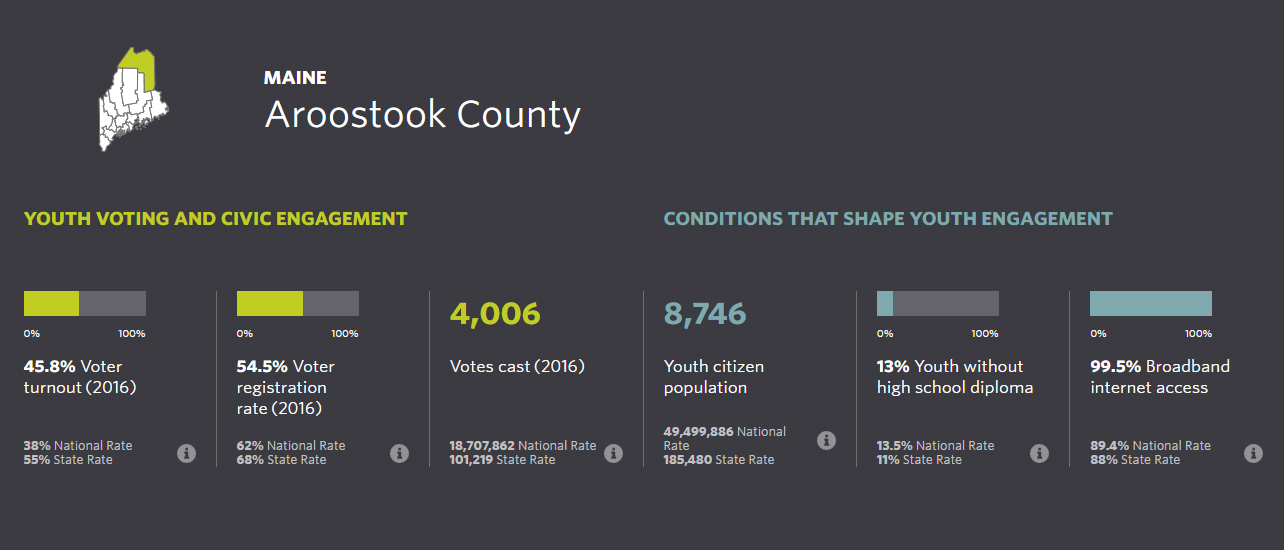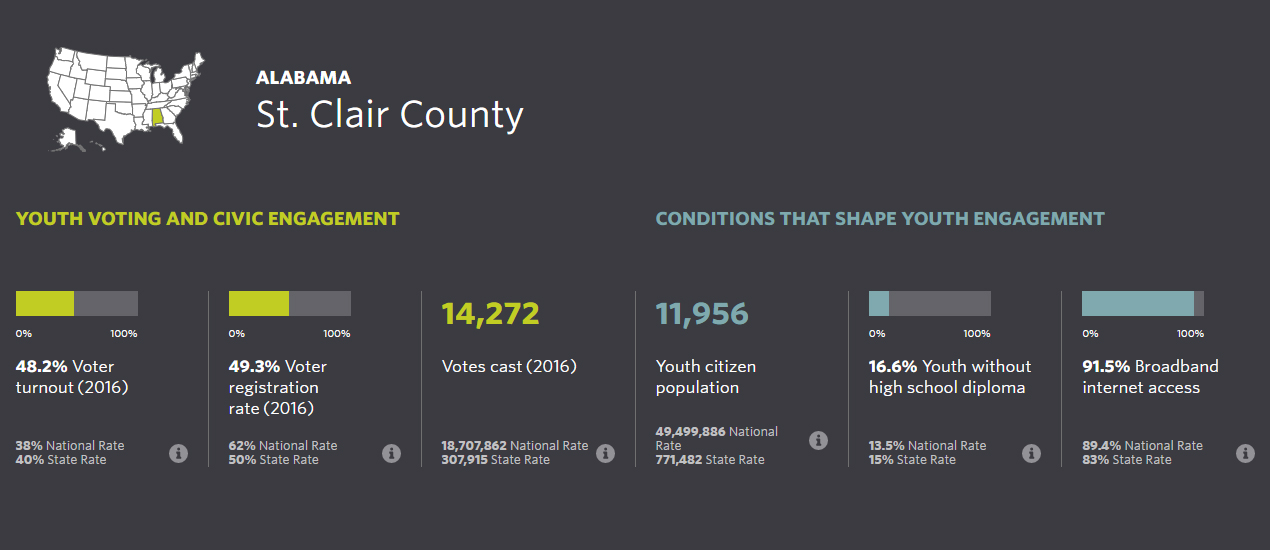Rural Youth Could Have Crucial Impact on Key 2020 Elections
In an unprecedented election cycle, rural young people could be a decisive electoral force this November. In half of the top 10 states identified by CIRCLE’s Youth Electoral Significance Index (YESI) as having the Presidential and Senate races where youth may have the biggest impact, at least a third of the population lives in rural areas. That creates extraordinary potential for rural youth’s voices to be heard across this country this year, and for their votes to sway the outcome in key Presidential, Senate, and House races this November.
This analysis examines the potential impact of rural young people in the 2020 elections, and looks at the conditions that shape engagement in those communities and that may be facilitating, supporting, or hindering rural youth’s civic and electoral participation. We analyze states in which, according to Census data, at least a third of the population lives in rural communities. We also look at counties and districts in which 50% or more of the total population lives in rural areas as per the Census. It is important to note that, although a given state may be considered mostly urban, specific areas within that state may be mostly or completely rural—e.g., the Minnesota 7th. When we refer to rural young people throughout this analysis, we mean young people living in rural counties as defined by Census data.
We find:
- Youth in Maine have above-average rates of voter turnout and engagement across nearly all indicators, and in the last presidential election rural young people cast nearly twice as many votes as their peers in urban areas of the state.
- In the perennial battleground state of Iowa, 37% of the population lives in rural communities, and rural young people could influence the outcomes of the Presidential, Senate, and several House races for the 2020 election.
- Rural Black youth have the potential to influence the Presidential and Senate races this year in states like North Carolina and Alabama. In both states, at least a third of the population is rural and more than a fifth of the population is Black.
- The Minnesota 7th district is mostly rural, and in 2018 rural young people in the district cast almost twice as many votes as the eventual margin of victory. The district’s rural population includes four tribal nations whose votes could be decisive in a tight race.
- There are potential barriers to political engagement for rural youth, particularly related to internet access. Our pre-election poll found that 1 in 10 young people in rural communities said they do not have the internet access they need. In some rural counties we examine, less than half of households have access to broadband internet.
Below, we profile some of the states and districts where rural youth could have a major impact:
Maine (#2 in Senate YESI; Maine 2nd Ranks #2 in House YESI)
Maine is the most rural state in the country; more than 60% of its population lives in rural communities. The Senate race between Republican incumbent Susan Collins and the Democratic challenger Sara Gideon is expected to be one of the closest in the country. Maine’s 2nd Congressional district race between Democratic incumbent Jared Golden and Republican challenger Dale Crafts is also expected to be very competitive. Rural young people could serve as a decisive voting bloc in both these tight races if they are effectively engaged and mobilized. Youth in Maine have above-average rates of voter turnout and civic engagement across nearly all indicators. In the last Presidential election, young people in mostly rural counties cast almost twice as many votes as their peers in urban counties.
Aroostook, Maine’s northernmost county, is one of the rural areas in Maine with the highest population and could be key to growing electoral participation. In 2016, the youth voter registration rate in Aroostook lagged behind the state's rate by 14 percentage points and youth voter turnout was 9 percentage points lower than the state average. The sheer size of the county may account for some challenges to electoral engagement: Aroostook is larger than the state of Connecticut, so access to transportation and physical locations where civic and electoral participation is supported may be an issue for some rural youth, especially those from low-income families. In our 2018 participatory research project focused on low-income youth, 35% of young people surveyed said they had no transportation to their polling place.
Voter registration could also be more challenging as Maine does not allow online voter registration. However, Maine voters can request a no excuse absentee ballot electronically, which potentially supports voter access for those who face transportation barriers or who have COVID-19 concerns. While the majority (88%) of households in Maine have access to broadband internet access, in three counties—Hancock, Sagadahoc, and Androscoggin—more than half of their households lack broadband internet access.

Iowa (#6 in Presidential YESI, #5 in Senate YESI)
This year, the Presidential, Senate, and three Iowa House races are high in our YESI rankings. More than a third (37%) of Iowa’s population lives in rural areas, and more than two-thirds (68 of 99) of Iowa counties have a largely rural population.
In 2016, in the five most populous rural counties in Iowa (Jasper, Benton, Clayton, Sioux, and Plymouth), young people cast more than 10,500 votes. As in more urban counties in Iowa, in these rural counties there was high youth voter registration and turnout in 2016 that exceeded the national average. This could be due to a number of factors: strong facilitative election laws, the additional political attention on the state which hosts the first-in-the-nation presidential caucuses, and good conditions at the county level, such as high rates of broadband internet access even across rural counties.
North Carolina (#2 in Presidential YESI, #4 in Senate YESI)
Experts expect the Presidential and Senate races in North Carolina to be among the most competitive in the country in 2020. A third (34%) of North Carolina’s population lives in mostly rural areas, and nearly two-thirds (64 of 100) of North Carolina’s counties are rural. In 2016, young North Carolinians in rural counties cast almost as many votes (164,539) as the margin of victory (173,315) in the Presidential race in the state. Because young voters tend to favor Democrats by a wide margin compared to the overall electorate in the state (in 2016: +22 in the Presidential election and +16 in the Senate race), youth likely contributed to the Presidential and Senate races in 2016 being so close. In addition, 1 in 5 people in North Carolina identify as Black, which suggests that rural young Black voters will be especially key in this election.
In the last Presidential election, the five largest rural counties in North Carolina (Johnston, Robeson, Randolph, Harnett, and Rockingham) accounted for more than 37,000 youth votes— one-fifth of the margin of victory in the Presidential race. In Johnston, Randolph, and Rockingham counties, youth voter registration and turnout came close to or exceeded statewide participation rates. In Harnett and Robeson counties, youth voter registration and turnout were lower than in the state as a whole, but the presence of multiple post-secondary institutions in both counties may mean there are avenues to build engagement and mobilize young voters.
North Carolina offers online voter registration, same-day voter registration during early voting days, and no-excuse absentee voting. People can also request absentee ballots online. A high percentage (93%) of North Carolina households have access to broadband internet. However, in about 10% of counties in the state, more than half of households lack access to broadband internet. As in other states, this can be a major structural challenge to effectively registering, engaging, and mobilizing rural youth in North Carolina.
Alabama (#13th in Senate YESI)
In 2017’s special U.S. Senate election in Alabama, young people were pivotal in Democrat Doug Jones’ victory; based on estimates from exit poll data, youth cast eight times as many votes as his margin of victory. This year, Jones faces former Auburn University football coach Tommy Tuberville (R) in a race that is projected to be close, and rural young people could influence the outcome. Forty-one percent of the population in Alabama lives in rural areas. In 2016, young people in rural counties cast over 100,000 votes, slightly more than a third of all the youth votes cast in Alabama. Furthermore, one in four residents of Alabama identifies as Black, which suggests rural Black youth could be a sizable portion of all youth votes cast and could impact the outcome of the Senate race.
Alabama has historically had lower youth electoral engagement than other states, due in part to underlying conditions that negatively impact all facets of young people’s lives: a high child poverty rate (26%), a high rate of youth without a high school diploma (more than 1 in 7), and a low rate of broadband access (83% of households). In fact, in more than 70% of counties in Alabama, only half or fewer households have high-speed internet access. So, while Alabama offers online voter registration, many young Alabamians may not be able to easily take advantage of it. At the same time, due to the pandemic, young people may have less access to physical locations like school and workplaces where they can register to vote and receive support and assistance to navigate the process, which may further impede their electoral participation.
St. Clair County, one of the rural Alabama counties with the highest population, exemplifies both some of the challenges and opportunities for engaging youth. In 2016, youth voter registration in St. Clair lagged behind the national average by 10 points, while youth voter turnout exceeded the national average by 10 points. This suggests campaigns and organizations are mobilizing voters once they have reached them, but are less effective or attentive to registering new voters and bringing them into the electorate. One reason may be that outreach through schools and colleges may reach fewer youth: St. Clair has no post-secondary institutions within the county, and 17% of young people (ages 18-24) in St. Clair County do not have a high school diploma.

Minnesota 7th District (#7th in House YESI)
Although most of Minnesota’s population lives in urban areas, in the mostly rural Minnesota 7th district 66% of the population lives in rural areas. The 2020 race in that district, between Democratic incumbent Collin Peterson and Republican challenger Michelle Fischback, is 7th on our YESI ranking of House races where young people could sway the outcome. The district has a history of close races and, in 2018, Peterson won by only 12,004 votes, with young people in the district casting more than double the margin of victory. The district contains multiple pivot counties (which voted for Obama in 2012 and Trump in 2016) and is one of just 30 Democratic-held House districts where Donald Trump won in 2016.
The Minnesota 7th is a relatively unique House race because Native Americans, including Native youth, could play a central role in shaping the outcome. The Red Lake Nation, White Earth Nation, Upper Sioux Community, and Lower Sioux Community are all located within the district, with a total estimated population of over 22,000 Native Americans. Fulfilling the electoral potential of tribal communities will require concerted efforts: Native Americans have been hit especially hard by COVID-19 and they have the highest rates of poverty and of youth neither in school nor working, which are both determinants of health and conditions that can hinder civic and electoral engagement. That said, Native American voters could be decisive in a tight race if they are effectively engaged, mobilized, and courted with a policy platform that includes and supports their communities.
Authors: Adam Strong, Kristian Lundberg


